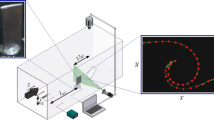Abstract
The geometry of the barn owl wing, that is, the planform, the camber line, and the thickness distribution, differs significantly from the wing geometry of other bird species of comparable weight and size. Moreover, the owl wing possesses special features like a velvet-like surface, fringes on the trailing edge, and a serrated leading edge. The influence on the flow field of one of the specific adaptations of the owl wing, namely the velvet-like surface structure on the suction side, was analyzed via high-speed particle-image velocimetry. Measurements were performed in a Reynolds number range of 40,000 ≤ Re c ≤ 120,000 based on the chord length and angles of attack of 0° ≤ α ≤ 6°. As a reference, a clean wing model which possesses the geometry of a natural owl wing with its distinct nose region and large thickness in conjunction with a small chordwise position of the maximum thickness was measured. A separation bubble on the suction side of the wing was found to be the dominant flow feature. The results were compared with measurements performed with the same model geometry covered with two artificial surface structures that resemble the surface of the natural wing to investigate the influence of these surfaces on the flow field. The first artificial textile, referred to as velvet 1, was selected to imitate the filament length, density, and thus the softness of the natural surface. Velvet 2, the second artificial texture, possesses longer, softer filaments and a preferred filament direction. A strong influence of the surface structures on the flow field was found for both velvet structures. The velvet seems to force the transition process in the wall-bounded shear layer at higher Reynolds numbers by redistributing the turbulent kinetic energy and thus enables the flow to reattach earlier. This leads to a stabilization and in some cases even to a reduction of the size of the separation bubble on the suction side of the wing.














Similar content being viewed by others
References
Bachmann T, Klän S, Baumgartner W, Klaas M, Schröder W, Wagner H (2007) Morphometric characterisation of wing feathers of the barn owl tyto alba pratincola and the pigeon columbia livia. Front Zool 4.23. doi:10.1186/1742-9994-4-23
Burgmann S, Dannemann J, Schröder W (2008) Time-resolved and volumetric piv measurements of a transitional separation bubble on an sd7003 airfoil’. Exp Fluids 44:609–622
Carmichael BH (1981) Low reynolds number airfoil survey. NASA CR-165803
Friedl A (2009) Video recordings of a natural flying barn owl. Personal communication
Graham RR (1934) The silent flight of owls. J R Aeronaut Soc 38:837–843
Hain R., Kähler CJ, Radespiel R (2009) Dynamics of laminar separation bubbles at low-Reynolds-number aerofoils. J Fluid Mech 630:129–153
Jeong J, Hussain F (1995) On the identification of a vortex. J Fluid Mech 285:69–95
Kim J, Moin P, Moser R (1987) Turbulence statistics in fully developed channel flow at low Reynolds number. J Fluid Mech 177:133–166
Klän S, Bachmann T, Klaas M, Wagner H, Schröder W (2008) Experimental analysis of the flow field over a novel owl based airfoil. Exp Fluids 46:975–989. doi:10.1007/s00348-008-0600-7
Klän S, Bachmann T, Klaas M, Wagner H, Schröder W (2012) Surface structure and dimensional effects on the aerodynamics of an owl-based wing model. Eur J Mech B Fluids 33:58–73
Lou W, Hourmouziadis J (2000) Separation bubbles under steady and periodic-unsteady main flow conditions. J Turbomach 122:634–643
McMasters JH, Henderson ML (1980) Low speed single element airfoil synthesis. Tech Soar 6:1–21
Mebs T, Scherzinger W (2000) Die Eulen Europas. Franck-Kosmos, Stuttgart
Monty J, Stewart JA, Williams RC, Chong M (2007) Large-scale features in turbulent pipe and channel flows. J Fluid Mech 589:147–156
Wilson PG, Pauley LL (1998) Two- and three-dimensional large-eddy simulations of a transitional separation bubble. Phys Fluids 10:1199–1207
Wissink J, Rodi W (2004) DNS of a laminar separation bubble affected by free-stream disturbances. No. 9 in direct and large-eddy simulation V. Springer, Norwell, MA
Acknowledgments
This research is funded by the Deutsche Forschungsgemeinschaft within the priority program “Nature-inspired fluid mechanics.”
Author information
Authors and Affiliations
Corresponding author
Rights and permissions
About this article
Cite this article
Winzen, A., Klaas, M. & Schröder, W. High-speed PIV measurements of the near-wall flow field over hairy surfaces. Exp Fluids 54, 1472 (2013). https://doi.org/10.1007/s00348-013-1472-z
Received:
Revised:
Accepted:
Published:
DOI: https://doi.org/10.1007/s00348-013-1472-z




